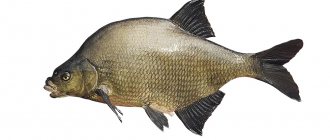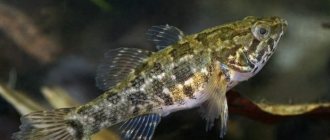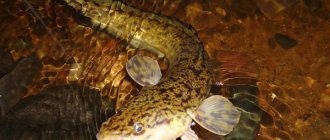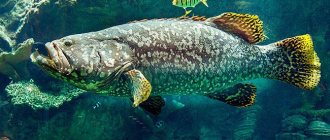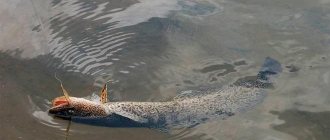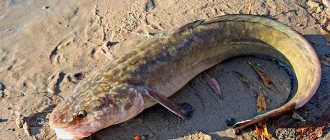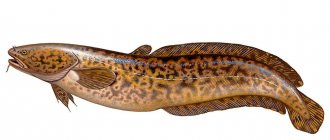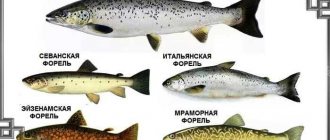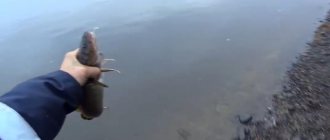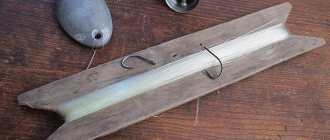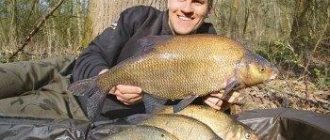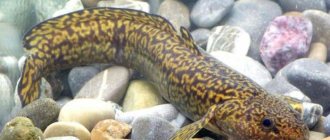You can’t call burbot beautiful, rather the opposite. Since ancient times, its extremely unpresentable appearance frightened people, and if the fish was accidentally caught, it was fed to dogs. Then people figured out that under the slippery greenish skin there was delicious dietary meat and healthy liver.
We will tell you what this valuable commercial fish looks like, where and when the largest burbot was caught, and where to go to break the record. And for starters, a couple of fishing tales, where would we be without them?
Ural legends about burbot
Our people don’t like anything slippery, large-mouthed and clumsy, take the same catfish, which was nicknamed the “devil’s horse.” Burbot did not receive a personal nickname, but there are legends about its vitality in the Urals. They say that the filling from whole gutted burbot itself comes out of the pie in a Russian oven, lies next to it 30 centimeters away and is quietly baked there. To be fair, we note that the largest burbot will not fit in the oven, and young fish are excellent for pie.
Another story gives burbots the amazing ability to crawl from the river into the field early on a foggy morning and attach themselves to the udders of grazing cows. And if you have to crawl past a dead animal, the burbot will not miss the opportunity to feast on carrion.
There is some truth in every story. Burbot are indeed extremely voracious, especially in the fall before spawning, and can eat aquatic carrion, and when caught in a common net, they continue to hunt small fish there. Previously, burbots were disdainfully thrown out of nets, but today every fisherman knows this fish and considers it a desirable prey.
What does burbot look like?
Despite the fact that this fish belongs to the cod family, burbot is not particularly similar to its closest relatives. It can be distinguished by a number of characteristic features:
- highly elongated, slippery body with small scales, rounded in front and compressed from the sides closer to the tail;
- wide, flattened head with a large mouth and small eyes;
- paired mustaches on the upper jaw and one long mustache on the chin;
- brownish, olive or dark gray color of the back, the belly is light, the whole body is covered with a spotted pattern.
Like all cod, burbot is not particularly large in size. The average length of adult fish is about 40 cm and weighs 2 kg. The largest burbot caught, the dimensions of which were officially confirmed, had a length of 120 cm. The weight of the record holder was 29 kg 970 g.
Description and maximum size of burbot
The body is elongated, rounded in the front part, closer to the tail - laterally compressed. The height is small. The length of the flattened head exceeds the maximum height of the body. The eyes are small. The mouth is large, located at the bottom of the head. The upper jaw is larger than the lower jaw. On the jaws and the head of the vomer bone there are small teeth shaped like bristles. There are no teeth on the palate. There are 2 antennae on the upper jaw and 1 unpaired antennae on the chin, the length of which is 20-30% of the size of the fish’s head.
The color may vary depending on the nature of the bottom of the reservoir where these representatives of the underwater fauna live, the transparency of the water, and lighting. In addition, the color changes as the underwater inhabitant ages: the fish becomes lighter. Because of this, the description of burbot may vary. Options range from black-gray, dark brown to light colors. On the lateral surfaces of the body and fins there are light spots of irregular shape, the size of which can vary. The belly is light, yellowish-white.
There are 2 dorsal fins. The short one is located closer to the head; the size of the one located near the tail is larger. The anal fin, located close to the rounded caudal fin, is also long. The pectoral fins have a rounded shape. On the abdominals, the second ray extends into a long sensitive thread.
The entire body is covered with small cycloid scales. Before the beginning of the caudal peduncle, a complete lateral line is observed, then it may be interrupted.
Sizes vary depending on habitat. The largest burbot is found in the Lena River: the mass of individuals is up to 18 kg. In length, burbot can grow up to 1.2 m. Average sizes vary from 60 to 80 cm. Unlike catfish, this representative of the marine fauna is smaller.
It is a commercial breed. Meat is rich in vitamins, potassium, phosphorus, magnesium, calcium, sodium. The presence of an allergic reaction is the only case when burbot meat can cause harm to the body, but the calorie content of the fish is low, so its consumption is acceptable on a diet for diabetes.
Where are burbot found?
This fish lives in cold rivers of Eurasia and North America, as well as in lakes of northern latitudes.
Previously, the burbot's range was extremely extensive, but today they are extremely rare in Germany, Austria and France, and have completely disappeared from the waters of Great Britain, Ireland and Belgium. In Scandinavian countries, burbot is quite common, although its numbers are declining in some places. But Russian fishermen catch burbot in all water bodies of the temperate and Arctic zones, and residents of Siberia can boast of the largest catch.
The largest burbot in the world was caught in the Norilka River basin in the north of the Krasnoyarsk Territory. The owner of the rare trophy was fisherman V. Kopylov, and since 1967 the Siberian’s record has not been repeated.
Population and species status
Photo: What burbot looks like
The range of burbot is quite wide - the fish is found in freshwater bodies of the northern regions of Europe, Asia and North America. In Europe, burbot is caught in New England (the fish is practically not found in Scotland and Ireland), in France (mainly in the Rhone River basin, somewhat less often in the upper reaches of the Seine and Loire), in Italy (mainly in the Po River), and also in the western cantons of Switzerland, in the Danube basin (almost everywhere) and in reservoirs belonging to the Baltic Sea basin. Not found (since the middle of the last century) on the west coast of the Scandinavian countries, as well as on the Iberian, Apennine and Balkan peninsulas.
In Russia, burbot is distributed everywhere - in reservoirs flowing in the Arctic and temperate zones, as well as in the river basins of Siberia - from the Ob to Anadyr, and throughout their entire length. In the European part of Russia, burbot is not found in the Crimea, Transcaucasia (with the exception of the lower reaches of the Kura and Sefidrud), sometimes this fish is caught in the North Caucasus - in the river basin. Kuban. The northern boundary of the range is the coast of the Arctic Ocean.
In the south, burbot is found in the Ob-Irtysh basin, and occupies a fairly wide range - starting from the upper reaches (Lake Teletskoye and Zaisan) and up to the Ob Bay. This fish is not found in Central Asia, although in the century before last this fish was actively fished in the Aral Sea basin. In the Yenisei and Baikal, burbot is caught almost everywhere. In the Selenga basin, the range descends to the south, all the way to Mongolia. Burbot is found throughout the river basin. The Amur River with its main tributaries - the Ussuri and Sungari. Found in the upper reaches of the Yalu River.
Regarding the Pacific coast, burbot is found on Sakhalin and the Shantar Islands, and even ends up in desalinated areas of the seas (where the water salinity does not exceed 12).
Habitat and size of burbot
The only cod fish that lives in fresh waters is burbot. Representatives of sedentary populations, permanently living in stagnant bodies of water, are the smallest and slowest growing, while large semi-anadromous burbots are found in rivers, for example, in the Lena and Ob. The size of burbot depends on the water temperature: the colder the river, the higher the chances of catching a large fish.
Although the largest weight of burbot is almost 30 kg, old-timers of Siberia claim that fish weighing 34 kg and 180 cm long were caught here. Unfortunately, the veracity of this data has not been confirmed, so when going fishing, do not forget the scales, tape measure and camera.
Burbot
0
Burbot, or lesser, is a rather unique fish. The fact is that burbot belongs to the order of cod-like fish and is the only species that lives exclusively in fresh water. Catching a burbot is already a great success, because its meat is very valuable, and this slimy fish is quite rare. If catching a burbot is not an easy task, then the chances of catching a large specimen are extremely low. But miracles do happen in 1985, on Lake Onega, a burbot weighing 16 kilograms was caught. Despite its colossal size, this giant did not become the largest recorded individual. The title was taken by a burbot caught in Siberia weighing 30 kilograms and measuring 1.2 meters in length.
4.
Where to look for burbot
These fish are extremely demanding on the quality of water and soil, so pollution of rivers and lakes has caused the extinction of the species in many areas of its range.
Burbots live best in clean, slow-flowing rivers with a water temperature of 0 to +10 °C. They avoid shallow water; they love depths of 3 m or more, clay or rocky bottoms with various shelters. By the way, the largest burbot fish was caught in ideal conditions. The Norilka River becomes covered with ice already at the end of September, and water transport resumes only in mid-June.
At water temperatures above +14 °C, burbot become lethargic, lose their appetite and hide in bottom shelters, so in the summer it makes no sense to count on a rich catch. Another thing is the off-season and especially winter. The best time to catch burbot is in the fall during the feeding period or from December when these fish spawn.
Experienced fishermen recommend using the following as bait:
- ruff or crucian carp;
- large worms: live or silicone;
- strips of lard;
- frozen shrimp;
- pieces of foam rubber, slightly soaked in fir oil;
- Albumin-based baits.
The best places for burbot to bite are steep river banks and rocky embankments. The optimal time is from sunset to dawn, because burbot does not like daylight. And according to the observations of the famous Russian zoologist L.P. Sabaneev, it doesn’t hurt to light a fire on the shore: for some reason, light in the night really attracts burbots. And of course, the rod must be tough and durable, in case you come across the biggest burbot in the history of fishing! The main thing is to remember to document the trophy before the fish goes to the table.
Benefits and calorie content of burbot meat
If you have the opportunity to catch burbot for future use, you will provide your family with a valuable dietary product that is useful for children and adults, pregnant women and everyone who cares about their health and figure.
100 g of burbot meat contains only 90 kcal, and there are no carbohydrates at all. The meat also contains a high content of vitamin B1, and useful microelements include iron and 7 amino acids essential for the body. Burbot meat tastes like lobster.
But the liver of this fish is very fatty and filling. Its calorie content is 613 kcal/100g, and among the useful components it is worth noting vitamins D, A, PP, C, E, B9 and a whole complex of minerals that improve cerebral circulation, vision and immunity.
Under favorable conditions, these fish live up to 24 years, and it is likely that somewhere in the depths of Siberian rivers the largest burbot is fattening, which could become your record-breaking trophy.
A unique representative of cod
Burbot is a prominent representative of the cod fish family, numbering more than 100 species. His closest relatives are:
- cod;
- pollock;
- navaga;
- blue whiting.
These fish live in seas and oceans, but burbot is found only in fresh water. This fish is highly valued in gastronomic terms. Fish liver is considered especially useful. Nutritionists say that it is saturated with all the necessary vitamins, minerals and beneficial components.
wildfauna.ru
